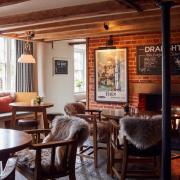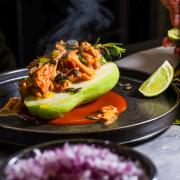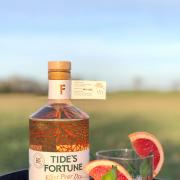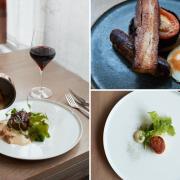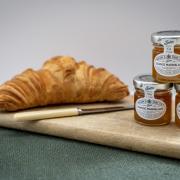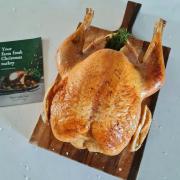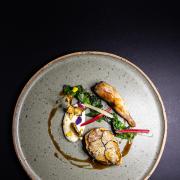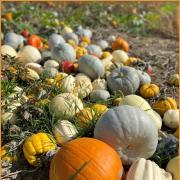Could a small corner of Essex, better known for Maldon salt and marshes, become England's top wine region?
The most oft-told, tirelessly romantic story about English wine is one of chalk and Champagne. The myth that has been perpetuated for many years is that the best English vineyards lie on the Paris Basin, the ring of chalk and limestone ridges that reach from Champagne, across the Channel, fly their white flags from the cliffs of Dover, and then fling themselves across the North and South Downs of southern England, but also reach as far north as Yorkshire.
I checked my seven books on English wine, and all but one spoke of the importance of this chalk and limestone as the central tenet for the validity of English wine. It is, for many, the firmly held belief that it’s because of these Champagne-like soils that this country makes such great sparkling wine, and that the greatest sparkling wine comes from these soils. It’s for this reason that the English counties which have become most synonymous with wine are Hampshire (two-thirds of Hampshire are on chalky soils) and Sussex (both counties are on the South Downs), and Kent and Surrey (which are on the North Downs).
Stephen Skelton MW was the first author and expert to directly and openly challenge this cherished credence. In his book The Wines of Great Britain English soils get but a passing mention, aspect and shelter getting far more emphasis in his classification of what makes a good site in this marginal wine region. When discussing the number of English vineyards planted on inappropriate sites, he writes, cynically, ‘“Planted on soil similar to that found in the best Champagne vineyards” looks so much better on a back label than “Planted on some of the toughest Wealden clay it was possible to find”’. He breaks the news that many excellent champagnes come from clay-rich soils, and that the reason the Champenois love their Chardonnay to be grown on high-water-capacity soils is because it makes for high yields and high acid.
Which is why England’s best-kept secret, especially when it comes to still, dry wines, is Essex, and, in particular, the Crouch Valley. I use the word secret not in a romantic sense. Many of the UK’s best-known wine producers, from the southernmost vineyards of the country and all the way up north, are buying fruit from Essex and have done so for many years. Some of them have even asked their Essex grape-growing partners to sign confidentiality agreements – God forbid the wine-drinking public should know that their grapes don’t come from their own vineyards!
Because the thing about Essex, and the Crouch Valley in particular, is that we’re talking about ‘feet of clay’. Sticky, yellow, claggy, cracky, unromantic clay. The River Crouch, as an LCA report says, ‘occupies a shallow valley between two ridges of London clay’, and it is the combination of this deep and very particular London clay, the aspects of these vineyards and the protected microclimate of this partially enclosed, tidal estuary that come together to cock a snook at the one-dimensional chalk story.
The Crouch Valley is one of the lowest-rainfall regions of England. It is also one of the sunniest. And the vineyards are on slopes. Mostly south and west-facing. And the estuary can be seen from the vineyards, you can smell the sea on the wind. All of this adds up to the magical formula for ripe wine grapes with great balance of acids and phenolics.
New Hall Wine Estate in Purleigh is one of the UK’s oldest and largest vineyards. It has a wine pedigree going back to 1120 (according to historical records, this was when the first vineyard was planted, 1.2 ha (3 acres) and the wine produced from it was, it is believed, drunk to celebrate the sealing of the Magna Carta in 1215) but its modern history began in 1969. Bill and Sheila Greenwood farmed arable at New Hall Farm and decided to plant 850 Reichensteiner vines, bought at an auction (23p each). The following year they planted 2,800 Huxelrebe and Müller-Thurgau vines, purchased from Germany. The first wine, 18 bottles, was made from 30kg of grapes in Sheila’s kitchen. Over the years, they planted more and more of their fields to vines, converted the cow shed into a cellar and began to win medals for their wines.
Today they have nearly 45 ha (110 acres) of vines, and while they’ve planted Pinot Noir, the majority of their myriad varieties are the old German crosses, and they still have some of the original vines, planted in the 1970s. The estate is still in family hands (it was taken over by son-in-law Chris Trembath in the 1980s and is now being run by his daughter, Becki) although Andy Hares manages their vineyards and winemakers Steve Gillham and Rachel Appleton head up the cellar team. New Hall makes their own wine (the 2022 harvest was processed in their brand-spanking-new winery) but a significant proportion of their grapes have always been sold to wine producers in other parts of the country because, even in poor vintages, they are reliably ripe. Chapel Down, for instance, is one of their regular customers.

Less than three miles away, heading south-west, in the tiny village of Stow Maries is Martin’s Lane Vineyard. Roy Martin (the name is coincidental, by the way!) noticed that the field behind the house they’d lived in since 1971 was up for sale. The gregarious, charismatic and clearly persuasive retired businessman gathered a cohort of family and friends and convinced them that they should club together, buy the field and grow grapes. He’d been in the valley long enough to see that grape-growing had profit potential. They formed a limited liability partnership (LLP) in 2008, and planting began in 2010 on a magnificent, steep, south-facing slope. When the first harvest delivered incredibly high-quality fruit, word spread very quickly.
Martins Lane Vineyard has gradually been acquiring more and more of the adjoining land and now they have more than 12 ha (30 acres) under vine, planted to Chardonnay, Pinot Noir, Pinot Meunier, Pinot Gris, Bacchus and Pinot Noir Précoce (and a little bit of Gewurz). Hedgerows have been retained, giving each block a unique microclimate. Although the original plan was to simply be wine-grape growers, it didn’t take long for the LLP to realise that it would be worth making their own wine with their sought-after fruit.
We stand at the top of the slope and breathe in the clear, long, stunning views of the Crouch estuary and the Essex landscape, the sky flung wide blue in front of us. ‘I’ve seen spring frost here just once in 15 years,’ Roy says. ‘And even then, it was down at the bottom, below the vines. But just three or four miles inland and you’re getting hammered every year.’ Looking at the immaculate bunches of grapes down every single row, tasting incredible ripeness, sweetness and texture from vine after vine, it’s easy to understand why so many English wine producers are lining up for this fruit. Roy tells me that some of the most prestigious producers in the country buy their fruit (‘but I’m not allowed to say who,’ he adds).
Ah, those non-disclosure agreements! I have new respect for the producers who put the source of their fruit on their labels. Exciting new producer Freedom of the Press and Devon-based Lyme Bay Winery are two of those buying Martin’s Lane Vineyard fruit, and they proudly acknowledge it.

Drive another three miles west and you’ll come to the very-much-not-missing gate of one of the newest winegrowers in the Crouch Valley, Missing Gate Vineyard. Businessman Nick Speakman and his wife Ali have a family farm, which was, for three generations, planted to arable. Nick is what one might describe as ‘a character’. He doesn’t stop talking, constantly takes the mick out of himself and everyone around him, is full of stories, pretends to know nothing about farming or grape-growing and claims to be stupid when it’s patently obvious that he’s as sharp as nails and knows exactly what he is doing.
With Ali and all three of his sons involved in one way or another, he converted the first of the farm’s south-facing, deep-clay arable fields (yip, views of the Crouch) to vineyard in 2018, and he’s still planting vines. The first crop, in 2020, went to make some of the most outstanding English wines I have ever tasted, including Gutter & Stars Daylight Upon Magic Chardonnay and Hope Is A Good Swimmer Pinot Noir, as well as Penn Croft Bacchus and Pinot Blanc. Their own Pinot Blanc 2020, tasted recently, is superb. And despite the grim weather of 2021, they’ve also managed to make very, very good Sauvignon, Pinot Blanc and Bacchus. Lyme Bay also buy MGV fruit – Sauvignon Blanc and Pinot Noir. New to the game, Missing Gate is a name that’s going to crop up again and again. Watch this space.
The Missing Gate wines are made by the gifted Ben Smith of Itasca Wines (a contract winemaking and wine consultancy business with a strong focus on sustainability, based at Penn Croft Winery in Hampshire). Linking all three of these winegrowers together is another key person: Duncan McNeil.
Having trained as a viticulturist in New Zealand, Duncan worked in Central Otago and the Pfalz before coming back to the UK to run New Hall’s 100 acres of vineyards as well as consulting for dozens of UK vineyards, new and established. In 2011 he struck out on his own as an independent viticultural consultant under his company MVM (McNeill Vineyard Management). Say the name ‘Duncan McNeill’ to almost any wine producer in the country and the response is a certain amount of awe.
Duncan could be accused of planting a significant percentage of the Crouch Valley vineyard, and he’s now responsible for farming a significant percentage of it. Having moved on from New Hall, he now manages the vineyards for Martin’s Lane Vineyard and Missing Gate, as well as Crouch Ridge, Clay Hill, Danbury Ridge, High House Weddings and Kingscote, among others.

We stop to taste some Pinot Noir (German clones), Sauvignon Blanc, and aromatic Chardonnay. The bunches are all perfect, literally perfect. Every grape. They’re loose, airy bunches which, McNeill says, is down to canopy management and pruning. We talk about drought and vine resilience, about change. Roy Martin’s words are on my mind. ‘All these fields you see now,’ he gestured at the farmland, much of it ploughed and brown post-harvest and one of the driest, hottest summers on record, ‘mark my words: this will all be vineyard in 10 years’ time.’ Nick Speakman calls it ‘the Essex Riviera’. In my degree module at the moment, I’m studying sea-level rise – East Anglia has one of the UK’s most vulnerable coastlines. There are coastal villages that are, day by day, falling into the sea right now. I wonder how an inexorably rising, warming sea will change this region in the decades to come. Might the Crouch Valley find itself under water?
In the meantime, arable farmers are becoming grape-growers, grape-growers are becoming winegrowers, wine producers are becoming grape-growers, business people are becoming vineyard owners and the vineyards are multiplying. British billionaire Mark Dixon has moved in and is buying up any land he can get hold of to supply fruit for his Kingscote wines. Danbury Ridge is considered by Jancis Robinson to produce ground-breaking Chardonnay and Pinot. Ross and Samantha Lonergan of Crouch Ridge have turned their dairy farm into a vineyard, tourist attraction and restaurant. Crouch Valley Vineyard supplies grapes to Lyme Bay, Tillingham, Flint Vineyard and London’s two urban wineries Blackbook and Renegade, among others. Clayhill Vineyard has a beautiful cellar-door café and also supplies grapes to Blackbook. And New Hall wine estate keeps doing what it’s always done.
It's a national joke, but perhaps the only way is Essex?




